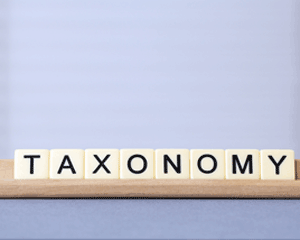The Value of Taxonomy: Why Taxonomy (Still) Matters

After decades of taxonomy design consulting, I’m still amazed that some organizations doubt the value of effective enterprise taxonomy design. Though knowledge and information management technologies, as well as associated search technologies have changed, the core business value and use cases for taxonomy have not.
The following is what we at EK have seen in practice as the most valuable outcomes for a well-designed taxonomy:
- Findability – The most common use case for taxonomy is, as we call it findability. In short, making it fast, simple, and intuitive for an end user to find what they’re looking for, either through search, browse, or any combination thereof. Taxonomy plays a number of roles here, from driving site navigation/information architecture, to improving search weighting, to enabling filtering/faceting on search.
- Discoverability – Going beyond findability, discoverability is about making end users aware of information they weren’t necessarily seeking, thereby providing them more complete answers. This is often surfaced via push recommendations. The idea here is that, with consistent taxonomy applied as metadata on content, tools can recommend content with similar metadata, helping users to find more than they were initially seeking.
Both findability and discoverability translate to more information getting to the user, ideally faster and more completely. This means less time looking for information and more time acting on a complete set of information. Moreover, improved findability and especially discoverability translates to a greater awareness of the information that already exists within the enterprise, meaning users are less likely to waste time recreating information that already existed within the enterprise but of which they were unaware. An additional element of this is:
- Awareness and Alignment – When we’re consistently tagging not just our content, but also our people with a well-designed taxonomy, we’re creating a great view of the organization as a whole. This means users are more likely to discover content elsewhere in the organization similar to that which they’re working upon, as well as people within the organization that hold similar or sought-after expertise.
Improved awareness and alignment means that users within an organization are more likely to connect with other end users that can help them learn, complete their tasks, or develop new knowledge. This translates to improved collaboration and coordination, with traditional silos of knowledge breaking down and new enterprise communities of knowledge and learning developing.
Over time, improved awareness and alignment results in greater upscaling of employees as they find and leverage people from whom they can learn more effectively, as well as improved innovation within the organization as more experts collaborate across geographic and organizational boundaries.
This leads to:
- Standardization – Enterprise taxonomy can align disparate systems, people, and processes, helping the organization to better communicate, collaborate, and integrate.
Standardization can result in lower administrative burden and greater integration of different information stores and organizational groups. Different systems that leverage the same taxonomies can be more effectively integrated in search. In addition, a great value add to effective enterprise taxonomy is that these controlled vocabularies begin seeping into conversations and day to day language, meaning that the overall way that people describe what their needs are and what they’re doing becomes more consistent, again, enabling greater collaboration and clearer communication.
As an organization begins mastering their overall information management with taxonomy, a common outcome is:
- Understanding – As taxonomy is consistently applied to content as tags, an organization has a better understanding of their content. A well-designed taxonomy applied consistently to content will ensure an organization understands what their content is about, who it’s for, and ideally, how it is being used.

Greater understanding of an organization’s content means that the organization can be more strategic about the content they’re creating and maintaining. An organization that understand what their content is about and how it is being used can identify gaps in their own knowledge and proactively work to address those gaps.
Moreover, understanding content can help an organization decide what is no longer of value and should be archived or dispositioned. This, in turn, reduces organizational overhead from maintaining content that shouldn’t be kept, and decreases organizational risk from keeping content that is old and outdated.
Though all of these taxonomy value propositions have held true over the decades, the most common conversation today is about:
- Artificial Intelligence Readiness – A well-designed enterprise taxonomy serves as a critical building block for an organization to design ontologies, a key element of Knowledge AI.
Organizations that are investing in taxonomy now will possess a distinct advantage in designing and establishing enterprise ontologies, opening the path to Knowledge AI and creating greater avenues to integrate their content, data, people, and everything else that matters to their business.
Still struggling to get started with taxonomies, unable to convince your leadership of their value, or ready to take the next steps in maturity to ontologies and AI? Give us a call and let’s get started.
 Expert in knowledge and information management strategy, content strategy, and taxonomy design. Zach is passionate about forming and supporting high-functioning teams and facilitating results-focused outcomes with his clients. More from Zach Wahl »
Expert in knowledge and information management strategy, content strategy, and taxonomy design. Zach is passionate about forming and supporting high-functioning teams and facilitating results-focused outcomes with his clients. More from Zach Wahl »
